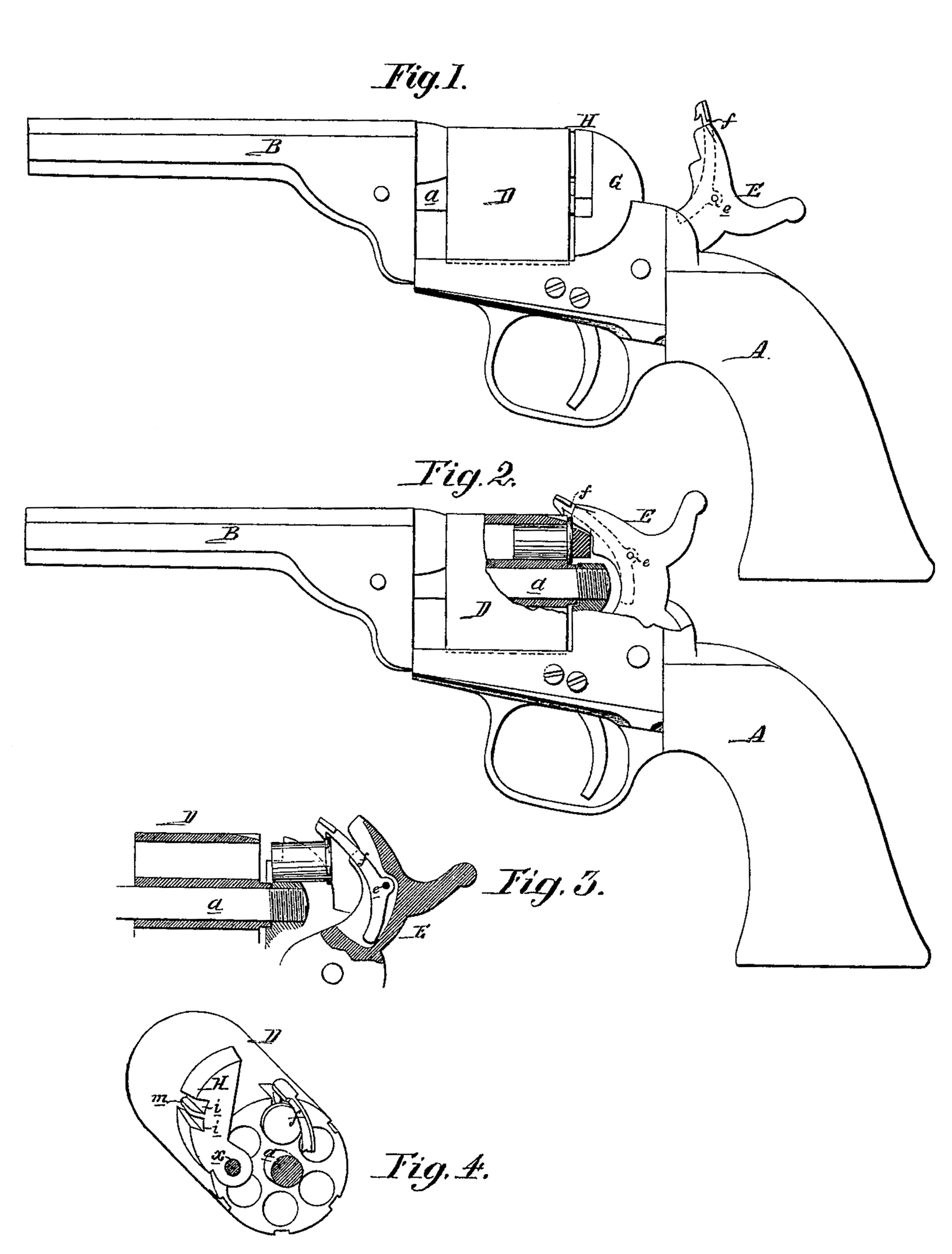US 109417
UNITED STATES PATENT OFFICE.
BENJAMIN F. JOSLYN, OF NEW YORK, N. Y.
IMPROVEMENT IN REVOLVING FIRE-ARMS.
Specification forming part of Letters Patent No. 109,417, dated November 22, 1870.
To all whom it may concern:
Be it known that I, BENJAMIN FRANKLIN JOSLYN, of New York, county of New York, State of New York, have invented an Improvement in Revolvers, of which the following is a specification.
My invention consists of a device, described hereinafter, whereby the hammer of a revolver can be used as a medium for extracting spent cartridges from the cylinder.
In the accompanying drawings, Figure 1 is a side view of a revolver with my improvement, the hammer being raised; Fig. 2, the same, partly in section, with the hammer depressed; Fig. 3, part of Fig. 2, illustrating the mode of extracting the spent cartridge-case; and Fig. 4, a perspective view of the barrel with my improvement.
A is the stock; B, the barrel; and D, the cylinder, the latter being arranged to revolve on a breech-pin, a on the movement of the hammer E in the usual manner. At the rear of the cylinder the frame G is cut away for the reception of the section H of a disk, as best observed in Fig. 4, and which is so hinged by a pin, x, to the frame that it can be elevated, as shown in that figure, or depressed. In the latter case it forms part of the breech-plate, which retains the cartridges in the boxes of the cylinder. In the front edge of the hammer E is a groove for the reception of a dog, f, which is hung loosely by a pin, e, to the said hammer, the outer end of the dog being hooked for catching hold of the edges of the metal cartridges. The hooked end of the dog projects beyond the end of the hammer, the latter being necessarily forked, owing to the groove in which the dog operates, so that the hammer has two faces, to strike the flange in two places, and the movable portion H of the breech has two notches, i i, for admitting the forked end of the hammer and permitting it to come in contact with the head of the cartridge when the piece A is depressed. Between the two notches i i in the movable piece H is a ridge, m, over the edge of which the end of the dog will ride without interfering with the cartridge. When this piece H is raised out of the way, however, as shown in Fig. 4, the hooked end of the dog, uncontrolled by any ridge, m, and having a tendency to fall by its own weight, will, if the hammer be operated, catch onto the flange of the cartridge and be the means of drawing the same from the bore.
When the bores of the cylinder have to be charged the piece H is elevated, as shown in Fig. 4, when a cartridge can be inserted into the uppermost chamber and the cylinder can be turned so that each chamber in succession may receive its cartridge, after which the piece H is depressed, and the weapon is ready for having its several loads discharged in succession in the usual in manner. When it is desirable to withdraw the spent cartridge the piece H is again elevated, and the operator, with a finger on the trigger and his thumb on the hammer, vibrates the latter and uses it as a lever for the extraction of the cartridges through the medium of the hooked dog.
It will be seen that by hanging the dog f so as to grasp the cartridge from above the necessity of employing a spring (which is unreliable) for operating the dog is avoided. I claim–
1. The hooked dog f, hung in the recess of a hammer, E, and arranged to be forced down by the hammer and catch the rim of the cartridge from above, as described.
2. The piece H, hung to the frame and arranged in respect to the cylinder as set forth.
3. The combination of the notches i i and intervening rib with the forked end of the hammer and hooked dog f.
In testimony whereof I have signed my name to this specification in the presence of two subscribing witnesses.
B. F. JOSLYN.
Witnesses:
WM. A. STEEL,
F. B. RICHARDS.

